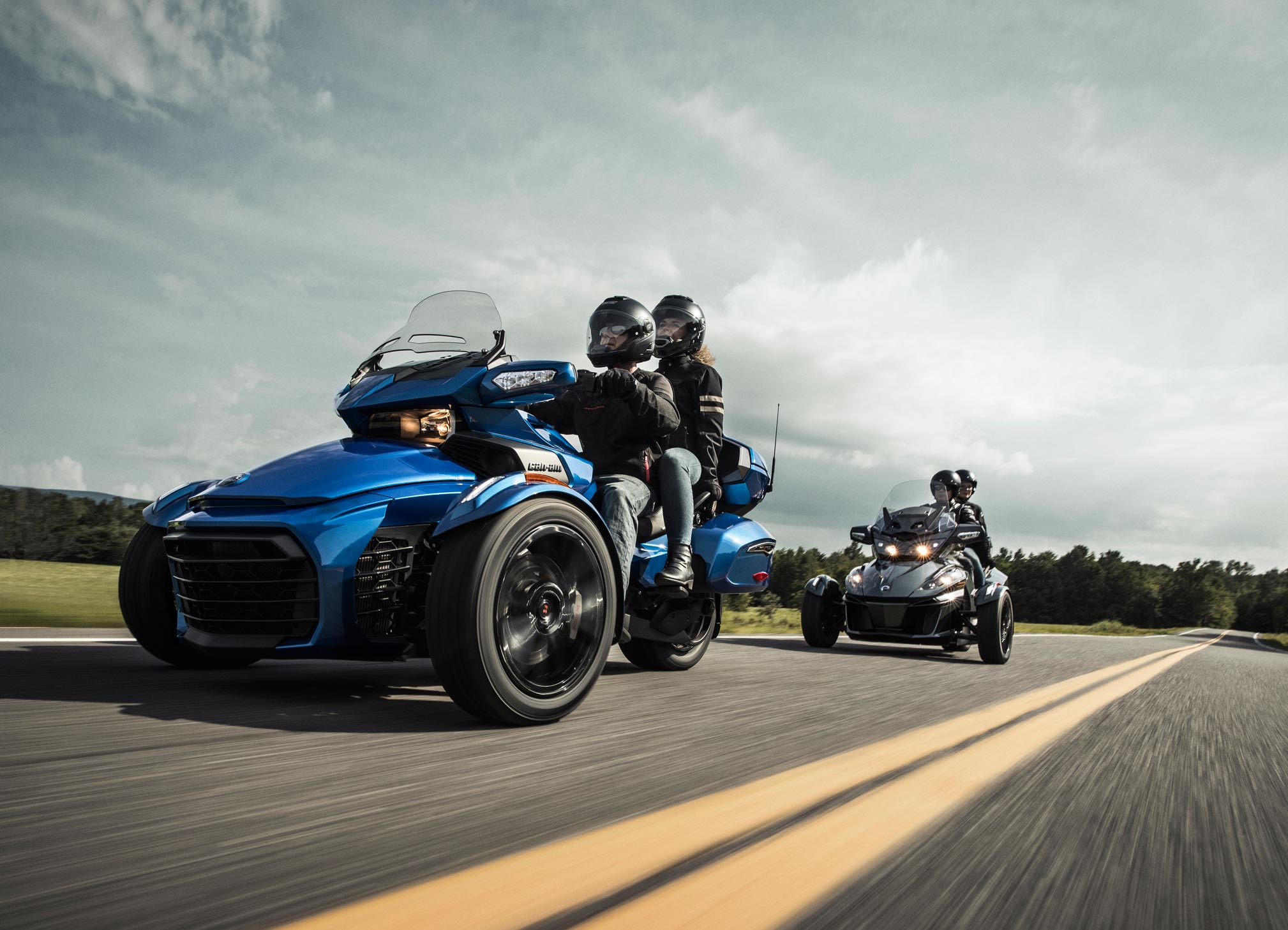

With three separate wheel tracks, however, it can be a challenge to dodge big potholes or debris in the road. The shocks are calibrated to deliver a comfortable ride, and they soak up a lot of abuse without upsetting the chassis. Thanks to double A-arms with an anti-roll bar in front, each wheel moves independently and the vehicle stays planted over irregular pavement and off-camber turns. Suspending the Spyder is a trio of Sachs shocks, with two non-adjustable Big-Bore shocks in front and a self-leveling air shock out back. Also standard on the RT Limited is hill-hold control, which maintains brake pressure on inclines to make it easier to pull away from a stop. The same basic systems described above are used on current models, but they are more advanced, so they respond more quickly and intervene more gradually. The Spyder’s electronic rider aids have evolved steadily over the last 15 years. Using inputs from an array of sensors, the Spyder’s Vehicle Stability System applies brake pressure to the outside wheel as needed. Those early models were also equipped with Can-Am’s Dynamic Powering Steering. As far back as the original 2007 Spyder, based on inputs from an array of steering, engine speed, wheel speed, and other sensors, VSS would reduce engine power or brake individual wheels to keep the vehicle under control. In addition to its Y-architecture, one of the Spyder’s early innovations was its Vehicle Stability System (VSS), which integrates ABS, EBD (electronic brake-force distribution), TCS (Traction Control System), and SCS (Stability Control System). Or you can set the cruise control, lean back, and enjoy the ride. A couple taps on the paddle shifter gets the engine closer to its torque peak to make a quick pass. In 6th gear, the Spyder maintains 70 mph at 3,600 rpm, nowhere near its 8,100-rpm redline, and its relaxed engine speed keeps vibration and harshness to a minimum. Out on the open road, the RT Limited gallops along with ease. Those issues fall to the wayside once the Spyder gets rolling, and the big Triple remains ultra-smooth throughout the rest of the rev range.

Both the standard and Eco ride modes exhibited a noticeable hitch in initial throttle application, and irregular power pulses plague the fuel-efficient Eco mode at lower speeds. The Spyder uses a throttle-by-wire system that sometimes delivers delayed responses. The Spyder has an electrically actuated parking brake, and when it comes time to back out of a downhill parking space, the reverse mode is a huge benefit. You can manually paddle shift into lower gears, or the electronically controlled transmission will do it automatically as you slow down, and it shifts into neutral at a stop. When ridden hard, each shift delivers a visceral power surge that eggs riders on. Using paddle shifters on the left switchgear, the 6-speed semi-automatic transmission delivers lightning-fast upshifts. Jackrabbit starts can even break the rear tire loose briefly before the traction control kicks in. With ample torque on tap throughout the rev range, the big RT blasts away from stops and launches out of corners, delivering smile-inducing exhilaration. Given that its power-to-weight ratio is about half that of many motorcycles, one might think the Spyder’s acceleration would suffer accordingly. For luxury touring, there is the Spyder RT platform, with three models also powered by a 1,330cc Triple: the RT, the RT Limited, and the ultra-primo RT Sea-To-Sky. Next up is the feet-forward, cruiser-touring Spyder F3 platform, with four models powered by a 1,330cc in-line Triple, including the F3, the F3-S Special Series, the F3-T with saddlebags, and the F3 Limited full-dress tourer. Each has a Sport or Rally ride mode that allows playful drifting on pavement or dirt.
#Spyder motorcycle plus
There’s the light, sporty Ryker platform, which includes a base model available with a 600cc parallel-Twin or 900cc inline-Triple, plus 900cc Sport and Rally models.

What started out as a single Spyder roadster powered by a 998cc V-Twin has grown into three distinct platforms that include a total of 10 models, with base prices ranging from $8,999 to $29,999. Photos by Kevin Wing.īRP’s Can-Am three-wheelers have come a long way since the first model was introduced back in 2007. The Spyder RT Limited is Can-Am’s fully loaded touring model, with generous rider and passenger accommodations, ample luggage capacity, and many other comfort and convenience features.


 0 kommentar(er)
0 kommentar(er)
